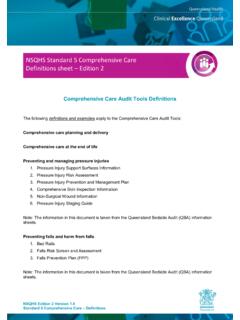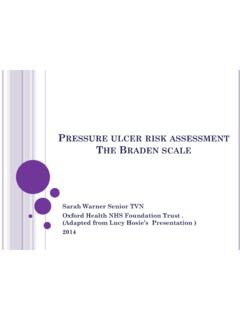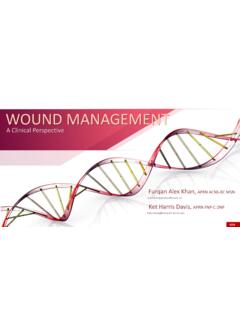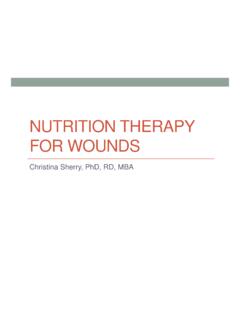Transcription of CARE PLAN CONCEPT MAP - Laura Norwalt
1 CARE PLAN CONCEPT MAP Student Laura Norwalt Date 3/16/13 3/17/18 Key to Coloring (Related color to nursing diagnosis) 1) Acute Pain 2) Impaired Skin Integrity 3) Risk for Falls Vitals BP P Resp Temp O2 % Admit 152/92 88 18 F 98 % Pre Clin. 141/79 96 18 F 98 % 0800 131/66 108 14 F 96 % 1200 136/69 88 16 F 95 % 1600 N/A N/A N/A N/A N/A Review of Systems Respiratory Respiration rate 14 breaths/min,unlabored and symmetrical. Bilateral breath sounds of posterior/anterior and upper/lower lobes clear. Nasal drainage/sputum absent. Nail beds and mucous membranes pink.
2 Cardiovascular S1 and S2 audible. Apical pulse 80 bpm at regular rhythm. Bilateral radial and carotid pulses palpable at regular, +2 strength. Right femoral pulse palpable at +2 strength. Left pedal pulse palpable at +2 strength. No edema noted. Upper and lower extremities warm. Capillary refill less than 3 seconds. Pain Pt. states 9/10 on pain scale . Pt. states pain located in lower right and left abdominal quadrants as Charlie Horse cramping. Deep inspiration worsens pain, observed as facial grimacing and frowning. Neurological AAO x 3. MAE equally. No complaints of numbness or tingling. Speech is clear. Musculoskeletal Past right AKA. All other extremities intact. Active ROM in all joints. Gastrointestinal NPO. Active bowel sounds audible in all 4 quadrants.
3 Upon light palpation, abdomen is soft, severe pain present in lower right quadrant, moderate pain present in lower left quadrant. Pt. states last bowel movement after surgery. Genitourinary Foley Catheter 22 Fr present and patent. Output 500 cc measured from urinary bag. Urine yellow and clear. Skin/Mucosa Skin is usual for ethnicity, warm, and dry. Mucous membranes pink and moist. Turgor elastic. 6 inch midline dressing along abdomen. Dsg. intact and dry with transparent tape and black sponge. present. Blanchable redness of left heel. Bilateral blanchable redness on buttock with pink dsg present. Psychosocial Calm and cooperative. Current Meds (Dose/Schedule) See attached. Home Meds See attached. Holistic Factors Support system- daughter and son Calm and cooperative Unemployed Developmental Ego Integrity vs.
4 Despair (Ego Integrity) (Involved with children and grandchildren) Admitting Medical Diagnosis: 1) Acute abdominal pain 2) Acute appendicitis 3) Open Appendectomy Chief Complaint: Abdominal pain Other Medical Dx. /Health Problems: PVD, HTN, R AKA, GERD, Peripheral Neuropathy, Migraines, Bronchitis Surgeries: aortogram, bilateral iliac stents, bladder lift, cholecystectomy, femoral popliteal bypass, R AKA, tubal ligation, hysterectomy Surgical History: Medical Orders Up ad lib. PT consultation. Braden scale Evaluation q24h. Skin Impairment Prevention Strategies. IV site observation q4h. NG tube to left nare, suction produces black, greenish drainage at 400cc. During care on 3/17/13, NG tube was discontinued and clear liquid diet was ordered. Pt. tolerated diet without nausea or vomiting.
5 Pt. has Foley Catheter. During care on 3/17/13, Foley catheter was ordered for discontinue. Urine specimen ordered for U/A with C & S. Pt. tolerated discontinuation well. 1) L antecubital- 22 gauge, no infiltration or drainage noted; NS infusing at 100 mL/hr with patency 2) Saline lock- R wrist, no infiltration or drainage noted; intact with dry, transparent dressing Labs / Diagnostic Studies (See attached) 3/15/13 CBC Auto Differential RBC L Neutro % 83 H Hct L Lymph % 8 L RDW L Lymph Absolute Ct. L Chemistry Panel Na 130 L K L Cl 96 L Ca L BUN 4 L Creatinine L Glucose 157 H Patient Strengths Support system- daughter and son Cooperative Positive Attitude Steady prayer life Teaching/Learning Educate on the importance of turning Q2H from supine to altering left and right sides and moving from bed to chair.
6 Educate on the importance of calling the nurse for assistance with ambulation by utilizing the call light. Discharge Planning Consultation with Pinnacle Home Health for PT,OT, and nursing care. (ordered 3/15/13- 1400) IV Site Assessment: History of Present Illness: Pt. presented to ER on 3/13/13 with acute abdominal pain. Cat scan was performed of abdomen and pelvis with oral and IV contrast. Diagnostic imaging confirmed acute appendicitis diagnosis. Procedures performed include exploratory laparotomy, lysis of adhesions, appendectomy, washout closure of abdomen, and wound placement. Pt. is stable, NPO, and in pain. Nursing Problems Nursing Care/Interventions Rationale Expected Outcomes Evaluation 1) Acute pain related to tissue damage secondary to surgical intervention AEB pt.
7 States 9/10 on pain scale that is described as Charlie horse cramps of abdomen. 2) Impaired skin integrity related to limited mobility and prolonged bed rest AEB bilateral blanchable redness of both buttocks and left heel blanchable redness. 1) Administer morphine as needed based on patient s stated pain level on pain scale . Nurse will follow up within one hour of morphine administration. - Rationale: pain medication acts on opioid receptors to decrease pain impulse; appropriate dosage is needed for stated pain level on pain scale 2) Cluster nursing tasks together, such as medication administration, vital signs, and bathing, to promote rest and relaxation for patient throughout shift. - Rationale: By clustering tasks together, this allows the patient to have long periods where she can try to fall asleep.
8 3) Promote comfort measures, such as prayer and visitation from son, 2 daughters, and grandchild throughout shift. - Rationale: Positive support system allows the patient to focus on her family which may decrease her perception of pain. Positive support system also promotes healthy healing. Rationale Reference: Ackley 600-605 1) Educate the patient on the importance of turning Q2H from supine to altering left and right sides during shift. The nurse will be available to assist in turning Q2H. - Rationale: By changing the patient s position, this removes continuously pressure on these sites which will prevent development of pressure ulcers. By educating the patient on the reasoning behind activities, this allows her to be part of her own care. 2) Monitor reddened areas for blanching q4h during shift.
9 - Rationale: The development of pressure ulcers is prominent in populations who have limited mobility. When redness becomes non-blanchable, this sign indicates stage I of a pressure ulcer development. 1) One hour after morphine administration, patient will state less than a 7/10 on the pain scale . 2) Pt. will report taking a restful half hour nap before 1200. 1) Patient s reddened areas on bilateral buttocks and left heel will remain blanchable and free of further skin breakdown during shift. 2) After teaching session, patient will state 2 reasons for the importance of turning q2h and getting up into chair at least once per day. 3) Patient will sit up in chair at least once during 8 hour shift. Pt. stated 7 out of 10 on pain scale after morphine administration.
10 Pt. stated took a 20 minute nap at 1000. Patient s redness areas on buttocks and left heel remain free of further skin breakdown and future complications during shift. Patient stated 2 important reasons for turning and moving from bed into chair, doesn t want to get a pressure ulcer and wants to relieve heel. At 1100, patient sat up in chair for one hour during shift. Nursing Problems Nursing Care/Interventions Rationale Expected Outcomes Evaluation 3) Risk for falls related to side effects of opioid analgesic (morphine) and limited gait (right AKA) AEB pt. appears drowsy and needs moderate assistance during ambulation from bed to chair. 3) Encourage the patient to sit up in chair at least twice a day under physician s order of up ad lib during shift.




